منصة إدارة علاقات العملاء (CRM) أمر لا بد منه قاعدة بيانات العملاء أداة لتتبع العملاء المحتملين والعملاء الحاليين ونقاط الاتصال وغير ذلك الكثير.
في حين أنك تحتاج بالتأكيد إلى تقنية قوية لتتبع جميع بيانات عملائك، إلا أن العمليات التي لديك لهذه التقنية أكثر أهمية.
ففي النهاية، ما فائدة المطرقة إذا كنت لا تعرف كيفية تثبيت الصورة على الحائط؟ ⚒️
لهذا السبب تحتاج كل شركة إلى عمليات قوية لإدارة علاقات العملاء. هذه هي الاستراتيجيات التي تستخدمها من أجل إدارة العملاء ودورة حياة العميل الكاملة - بدءًا من أول تفاعل له معك وحتى الدعم المستمر وفرص زيادة المبيعات.
أنت تنفق الوقت والمال على نظام إدارة علاقات العملاء، فلماذا لا تستفيد من هذا الاستثمار؟
في هذا الدليل، سنشرح في هذا الدليل ما هي عمليات إدارة علاقات العملاء، وكيف تبدو دورة عملية إدارة علاقات العملاء النموذجية، وكيفية تحسين عملية فريقك باستخدام نظام إدارة علاقات العملاء المناسب.
ما هي عملية إدارة علاقات العملاء؟
عملية إدارة علاقات العملاء هي مجموعة من الخطوات التي يتبعها فريقك لإدارة علاقات العملاء. فكر في الأمر على أنه استراتيجية إدارة علاقات العملاء مصممة للحفاظ على إنتاجية فريقك وتناغمه مع احتياجات عملائك. 🙌

استخدام ClickUp كإدارة علاقات العملاء وإدارة بيانات العملاء في طريقة عرض قائمة ClickUp
لا يوجد شيء اسمه عملية إدارة علاقات العملاء بمقاس واحد يناسب الجميع لأنها تعتمد كليًا على نموذج عملك ومنتجاتك وفريدتك رحلة العميل . ومع ذلك فإن المؤسسات التي لديها عملية إدارة علاقات العملاء قادرة على
- تحديد العملاء المحتملين وتأهيلهم
- رعاية العملاء المحتملين من خلال مسار المبيعات
- إغلاق الصفقات
- تقديم دعم متميز للعملاء
- زيادة المبيعات والبيع المتبادل
عمليات إدارة علاقات العملاء ليست فقط للأشخاص في فريق المبيعات لديك. فالهدف من وجود عملية إدارة علاقات العملاء هو منح العملاء المحتملين والعملاء الحاليين تجربة مميزة في كل مرحلة من مراحل رحلتهم.
نظرًا لأن كلاهما يتفاعلان على الأرجح مع فرق مختلفة خلال تلك الرحلة، فإن كل شخص في مؤسستك يشارك في هذه الرحلة. 🚗
يجب أن تشمل عملية إدارة علاقات العملاء الخاصة بك كل شخص في شركتك لديه أي مشاركة في دورة حياة العميل. قد يشمل ذلك أشخاصًا مثل فريق التسويق والمنتج وخدمة العملاء وبالطبع مندوبي المبيعات.
لماذا أحتاج إلى عملية إدارة علاقات العملاء؟
نحن ندرك أنك مشغول. قد تتساءل، "لماذا أحتاج إلى إنشاء عملية منفصلة فقط لاستخدام إدارة علاقات العملاء؟ أليس من المفترض أن تتولى أداة إدارة علاقات العملاء كل شيء؟
لا.
تذكر أن إدارة علاقات العملاء هي مجرد أداة. الأمر متروك لفريقك لاستخدام هذه الأداة بطريقة مدروسة واستراتيجية لكسب مشترين جدد والاحتفاظ بالعملاء.

تصوّر المهام والمشروعات وسير العمل بالطريقة التي تناسبك بشكل أفضل مع أكثر من 15 طريقة عرض قابلة للتخصيص في ClickUp
إذا كنت قد استثمرت في حل إدارة علاقات العملاء ولم ترَ قيمة كبيرة من هذه التقنية، فقد لا يكون السبب هو الأداة على الإطلاق، بل قد يكون غياب الاستراتيجية.
عندما الجمع بين عمليات إدارة علاقات العملاء وإدارة المشاريع سترى مجموعة من الفوائد مثل:
- إدارة أفضل للبيانات: يخزن نظام إدارة علاقات العملاء جميع معلومات وبيانات العملاء في مكان واحد. تسجل معظم أنظمة إدارة علاقات العملاء تلقائيًا جميع تفاعلات العملاء وتمنحك أدوات لتحليل هذه البيانات على مستوى عالٍ. بدلاً من السماح لبيانات العملاء أو الجمهور المستهدف بالتشغيل بشكل عشوائي، قم بتأسيس عمليات إدارة علاقات العملاء لتحقيق أقصى استفادة من ميزة إدارة علاقات العملاء هذه
- نواتج محسنة: سواء كنت ترغب في تحسين جهودك التسويقية أو كان مندوبو المبيعات لديك بحاجة فقط إلى سير عمل أنظف، فإن عملية إدارة علاقات العملاء تدعم العمل بجودة أعلى. فهي تمنح فريقك دليلاً مثبتاً للنجاح، بحيث لا يضطرون للتفكير فيما يجب عليهم فعله أو متى يفعلون ذلك
- المزيد من الوقت والمال: هل يقضي فريقك ساعات كل أسبوع في البحث عن بيانات التسعير أو متابعة البريد الإلكتروني أو معلومات الاتصال؟ كل ذلك يكلفك الوقت والمال، مما يؤثر على أرباحك النهائية. تبنَّ عمليات إدارة علاقات العملاء لوضع كل شيء في نظام واحد وزوِّد فريقك بالمهارات والعمليات لإنجاز العمل بشكل أسرع
- المواءمة بين الأقسام: من لديه الوقت للتعامل مع الصوامع؟ إذا كنتشركة قائمة على الخدماتفإن برنامج إدارة علاقات العملاء أمر بالغ الأهمية لمنح عملائك تجربة رائعة. فهو يوفر عرضًا كاملاً لسجل كل عميل حتى تتمكن الأقسام المختلفة من متابعة الأمور بسهولة من حيث توقف الفريق السابق
حوّل التعليقات إلى مهام ClickUp أو قم بتعيينها لتحويل الأفكار إلى عناصر عمل على الفور
الخطوات الخمس الأساسية في دورة عملية إدارة علاقات العملاء
قبل أن نتعمق في التفاصيل الدقيقة لكيفية تحسين عملياتك الحالية، نحتاج إلى فهم كيفية عمل عملية إدارة علاقات العملاء.
إذا لم يكن لديك دورة عملية لإدارة علاقات العملاء الخاصة بك، فأنت بحاجة إلى دورة عملية واحدة. أنت حر في إضافة دورتك الفريدة الخاصة بك. بشكل عام، يجب أن تتبع دورة عملية إدارة علاقات العملاء الخطوات الخمس التالية.
الخطوة 1: تحديد العملاء المحتملين
أول الأشياء أولاً - تحتاج إلى العثور على العملاء المحتملين. بعض الشركات تنشئ عملاء واردين حملات تسويقية لاكتساب عملاء محتملين بينما يتخذ آخرون نهج التسويق القائم على الحساب ويستكشفون العملاء المحتملين واحدًا تلو الآخر. ستؤدي جميع الطرق إلى نفس المكان: بناء قائمة من العملاء المحتملين تدريجيًا والتي ستقوم بغربلتها لاحقًا.
الهدف في هذه المرحلة هو جعل عملك جذابًا قدر الإمكان لجمهورك المستهدف. على سبيل المثال، قد يقوم فريق التسويق الخاص بك بإنشاء شخصية العميل لمساعدتهم على ضبط رسائل البريد الإلكتروني ووسائل التواصل الاجتماعي والرسائل الإعلانية. 📌
ستقوم معظم برامج إدارة علاقات العملاء، مثل ClickUp أو HubSpot أو Salesforce، بجمع البيانات تلقائيًا عن هؤلاء العملاء المحتملين أثناء تفاعلهم مع شركتك.
الخطوة 2: تأهيل العملاء المحتملين
يحتوي نظام CRM الخاص بك الآن على قائمة متزايدة من العملاء المحتملين المحتملين. ولكن هناك مشكلة صغيرة واحدة فقط: ليس لديك أي فكرة عما إذا كان هؤلاء الأشخاص هم قاعدة عملائك المثالية.
إذا كنت شركة B2B تخدم الشركات الصغيرة، فربما لا ترغب في التعامل مع عميل مؤسسي، أليس كذلك؟ إذا دخل عميل غير ذي صلة بطريقة ما إلى برنامج CRM الخاص بك (وسيفعلون)، فأنت بحاجة إلى طريقة لفرز العملاء المناسبين بالفعل وترك الآخرين. 🌻
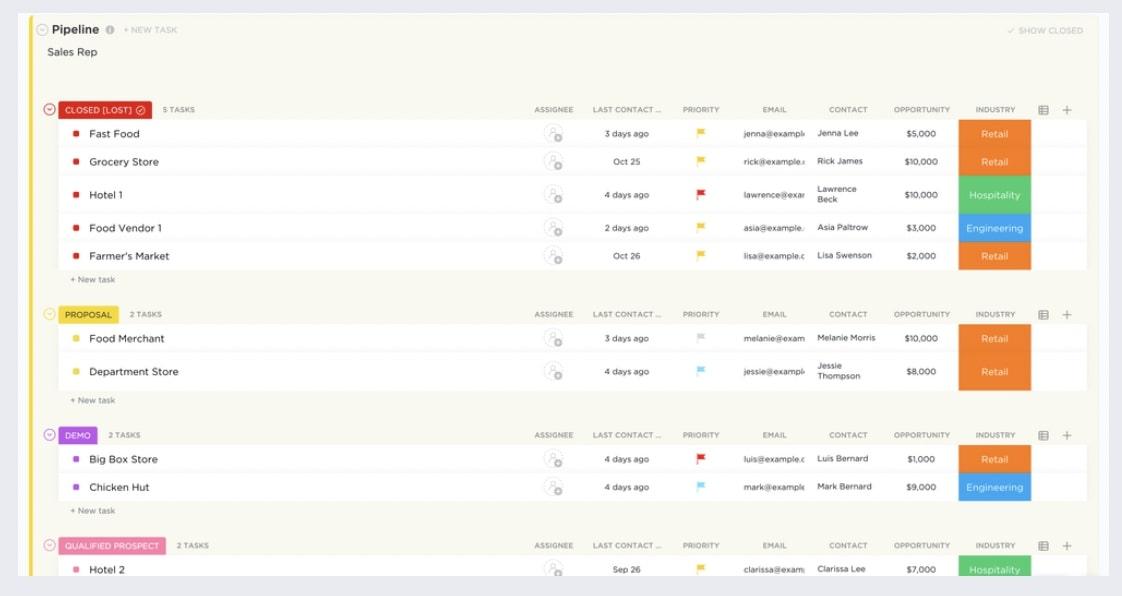
هنا يأتي دور تأهيل العملاء المحتملين. تبحث هذه المرحلة من عملية إدارة علاقات العملاء في بيانات كل عميل وتقارنها بالتركيبة السكانية المستهدفة. إذا كنت تستخدم أداة مثل قالب خط أنابيب المبيعات ClickUp من السهل غربلة العملاء المحتملين ودفع الأشخاص الأكثر صلة إلى أعلى القائمة.
الخطوة 3: رعاية العملاء المحتملين
تهانينا! لديك الآن قائمة من العملاء المحتملين المحتملين. هنا تبدأ المتعة الحقيقية. 🎉
في هذه المرحلة، ينشغل فريق التسويق لديك بالتواصل مع العملاء. لن يقوم نظام إدارة علاقات العملاء الصحيح بتتبع معلومات وبيانات العملاء فحسب، بل سيدعم وظائف مثل أتمتة التسويق - وهذا يجعل من الأسهل بكثير القيام برعاية العملاء المحتملين على نطاق واسع.
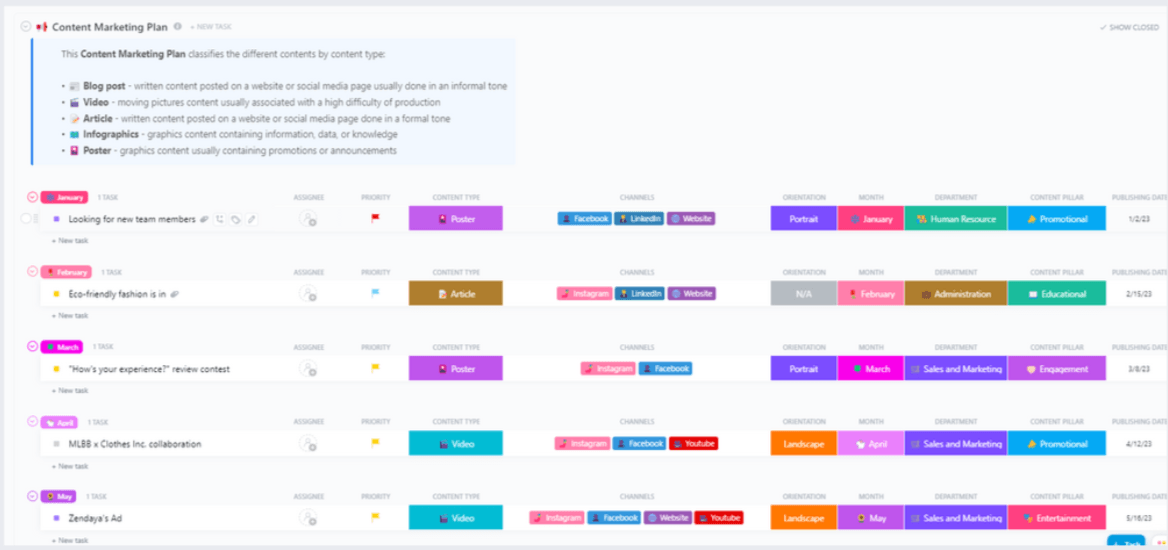
ارتق بمستوى تخطيط المحتوى الخاص بك مع قالب خطة تسويق المحتوى ClickUp وتوافق مع فريق المبيعات الخاص بك لتقديم محتوى عالي الجودة لجمهورك المستهدف
يجب أن يسجل نظام CRM الخاص بك نقاط الاتصال عبر جميع قنوات الاتصال. لا تتردد في إرسال دراسات حالة العملاء المحتملين عبر التسويق عبر البريد الإلكتروني أو الدردشة معهم على وسائل التواصل الاجتماعي.
سيقوم نظام إدارة علاقات العملاء الخاص بك بتسجيل جميع تفاعلات العملاء وإرسال تنبيهات إلى فريقك عندما يكون كل عميل محتمل جاهزاً للمرحلة التالية من دورة حياة العميل.
الخطوة 4: إغلاق الصفقات
بعد ذلك، ستقوم أداة CRM بتنبيه فريق المبيعات عندما يكون العميل جاهزًا للمرحلة التالية. تبدأ عملية المبيعات رسميًا عندما يتواصل المندوبون مع العميل بطلبات العرض التوضيحي ومعلومات التسعير وغيرها من الإجراءات الخاصة بالشراء.
ستفشل معظم الصفقات، لذا لا تقلق إذا لم تتمكن من تحويل العملاء المحتملين في كل مرة. ولكن مع وجود عملية إدارة علاقات عملاء قوية تدعمك، سيتمكن فريق المبيعات لديك من التواصل في الوقت المناسب مع العملاء المحتملين وتحويل المزيد من هؤلاء العملاء المحتملين إلى عملاء جدد. 🎯
الخطوة 5: تقديم الدعم للعملاء
لا تنتهي تجربة العميل بعد إجراء عملية الشراء، أليس كذلك؟
بالنسبة لعملائك، المتعة بدأت للتو. أنت الآن بحاجة إلى تنفيذ جميع وعودك الكبيرة، وهنا يأتي دور فريق الدعم الخاص بك.
إن رضا العملاء هو عامل كبير في الاحتفاظ بالعملاء وولاء العملاء. فبدلاً من أن تتمنى أن يكون عملاؤك سعداء معك، ستقوم عملية إدارة علاقات العملاء بالتحقق تلقائيًا من درجة حرارة كل حساب.
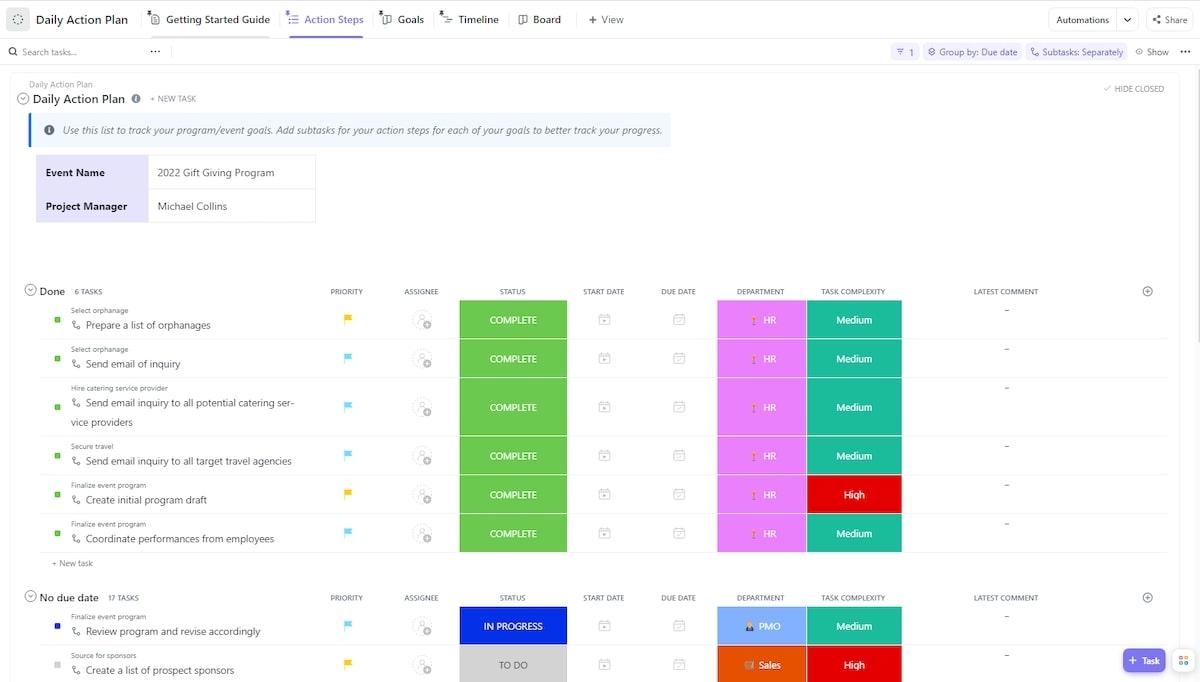
تتبع المهام المتعلقة بمشاعر العملاء وترتيبها حسب الأولوية والتعقيد والقسم في قالب خطة عمل إرضاء العملاء ClickUp
على سبيل المثال قالب خطة عمل إرضاء العملاء ClickUp يجعل من السهل الاطلاع على درجات رضا العملاء في الوقت الفعلي إلى جانب أداء الموظفين.
لا تسقط الكرة مرة أخرى. مع وجود عملية إدارة علاقات العملاء الصحيحة، سيتمكن فريق الدعم الخاص بك من الإجابة عن الأسئلة بسرعة وحل المشكلات ومنح العملاء الخدمة الممتازة التي يتوقعونها (ويستحقونها). 🤩
كيفية تحسين عملية إدارة علاقات العملاء الخاصة بك بشكل أفضل
إن وجود عملية منظمة لإدارة علاقات العملاء يُحدث فرقًا بين تجربة عملاء لا بأس بها وتجربة رائعة تعزز ولاء العملاء وربحيتهم. للحصول على المزيد من الاستفادة من إدارة علاقات العملاء الخاصة بك، اتبع هذه النصائح لتحسين عملية إدارة علاقات العملاء الخاصة بفريقك.
1. احصل على أفضل إدارة علاقات عملاء للوظيفة
تُحدث العمليات فرقًا كبيرًا في مؤسستك. ولكن حتى مع ذلك، يجب أن تبدأ بمنصة CRM قوية. وهنا يأتي دور ClickUp.

عزز استراتيجيات إدارة الممتلكات الخاصة بك مع قالب عقارات ClickUp البسيط لإدارة علاقات العملاء من ClickUp ClickUp CRM هو منصة قابلة للتخصيص لتصور خط أنابيب المبيعات الخاص بك، وتبسيط سير العمل، والتعاون مع فريقك. شاهد جميع علاقاتك مع العملاء على مستوى عالٍ من خلال أكثر من 10 طرق عرض مرنة. تتبع أحجام الصفقات وقيمة عمر العميل وأي مقياس آخر إلى حد كبير باستخدام أدوات لوحة معلومات ClickUp Dashboard.
لكن ClickUp ليس مجرد إدارة علاقات العملاء. إنه نظام متكامل أداة لإدارة المشاريع التي تدمج جميع العمليات التجارية في مساحة عمل واحدة سهلة الاستخدام، بدءاً من الحملات التسويقية وحتى دعم العملاء. حتى أنه يتكامل مع أدوات العمل المفضلة لديك، مثل Slack وZoom، للحفاظ على جميع أعمالك في منصة واحدة متماسكة.
2. استخدم قوالب العمليات
لماذا تعيد اختراع العجلة بينما يمكنك ببساطة ترقية العملية الخاصة بك؟ قوالب ClickUp CRM تجعل من السهل تبني استراتيجية إدارة علاقات العملاء العاملة دون البدء من الصفر.
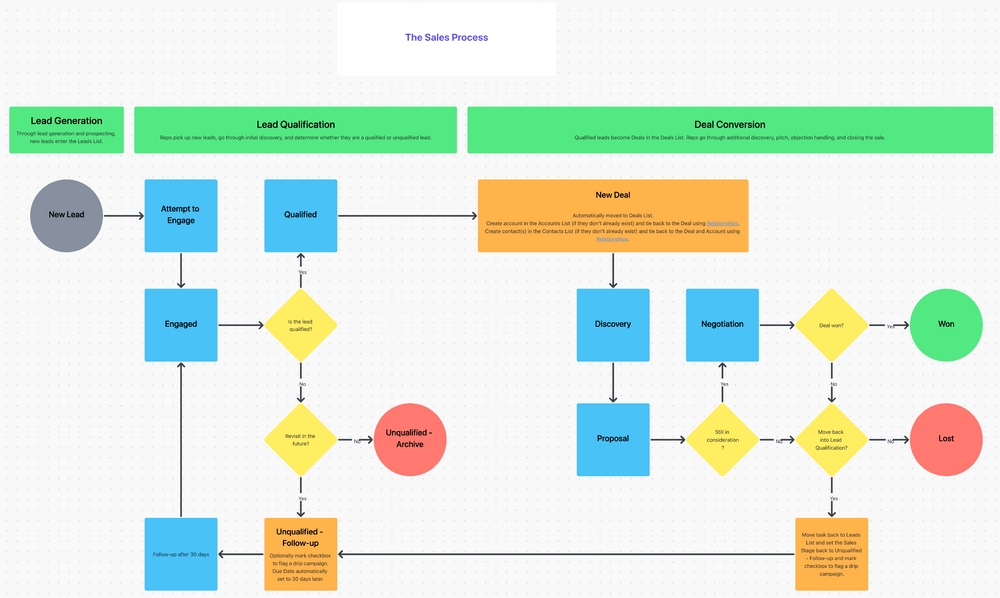
استخدم نموذج إدارة علاقات العملاء من ClickUp لتخطيط سير عمل إدارة علاقات العملاء الأتمتة في ClickUp Whiteboards
ال قالب ClickUp CRM مثالي لأي شركة صغيرة أو شركة ناشئة تتطلع إلى إنشاء إدارة علاقات عملاء بسيطة لكنها قوية للهيمنة على العالم. 🏆
3. القيام برسم خرائط مرئية للعمليات
ربما لم تقم بتوثيقها بشكل رسمي، ولكن من المحتمل أن يكون لديك عمليات إدارة علاقات العملاء في الوقت الحالي. بدلاً من الاندفاع وإصدار المراسيم الخاصة بسير العمل الجديدة، فكر في الأمور مسبقًا.

قم بتحويل الأشكال إلى مهام على لوحة ClickUp Whiteboard لبدء وضع المخطط الانسيابي الخاص بك موضع التنفيذ على الفور
استخدم أداة تخطيط العمليات لتبادل الأفكار حول هذه التغييرات مع فريقك. تساعد أداة التصور الجميع على فهم عملياتك الحالية والتحسينات التي تريد إجراءها.
وأفضل ما في الأمر أن الأداة تجعل من السهل تعديل عملية إدارة علاقات العملاء أثناء العصف الذهني، بحيث تفكر حقًا في الأمور قبل طرح التغييرات الكبيرة.
4. الاستفادة من الأتمتة
الأخطاء البشرية تحدث. آخر شيء تريده هو أن يقوم مندوب المبيعات بكتابة عنوان بريد إلكتروني أو رقم هاتف خاطئ عن طريق الخطأ لعميل محتمل مهم. أتمتة ClickUp الكثير من العمل الشاق لفريقك حتى يتمكنوا من التركيز على رعاية العملاء المحتملين وليس إدخال البيانات.
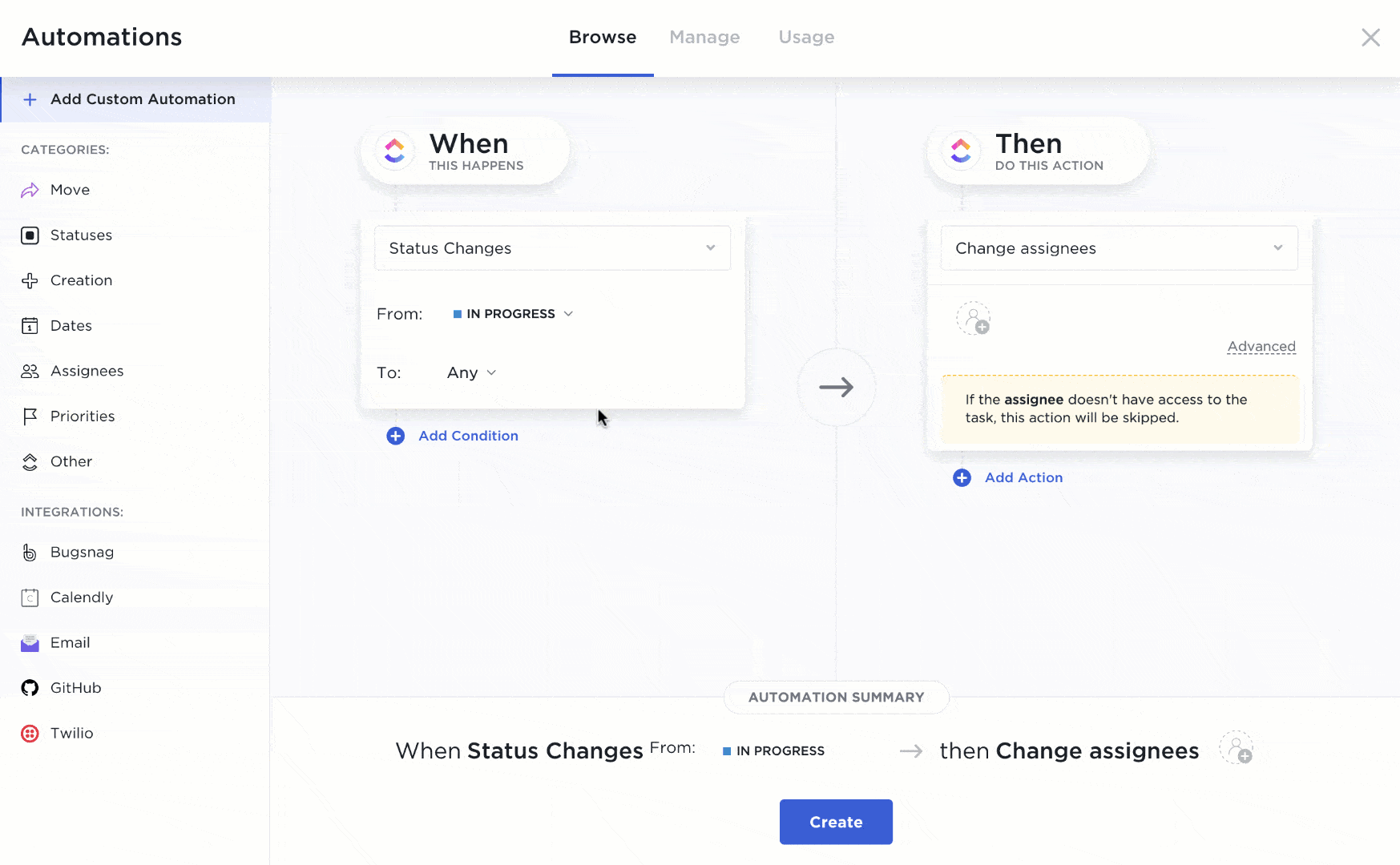
أتمتة توليد العملاء المحتملين, إدارة المهام وإعداد التقارير، وغير ذلك الكثير مع أكثر من 100 عملية أتمتة في ClickUp. سواء كنت ترغب في تسليم العملاء المحتملين تلقائيًا من التسويق إلى المبيعات، أو تعيين مستويات الأولوية إلى جهات اتصال مختلفة، أو تحويل جهات الاتصال إلى مهام، فهناك أتمتة لذلك.
5. تدريب فريقك
العمليات رائعة، لكنها لا تعني شيئًا إذا لم يتبعها فريقك. درّب الجميع على كيفية استخدام تقنية إدارة علاقات العملاء وعملياتك. قدم تدريبًا مباشرًا وتسجيلات يمكن لفريقك الرجوع إليها لاحقًا إذا كانت لديهم أسئلة.
أيضًا، لا تخبر موظفيك فقط، "هذه هي الطريقة التي تسير بها الأمور" اشرح السبب وراء لماذا اخترت هذه العملية ولماذا هي مهمة. عندما يفهم الموظفون أهمية سير العمل لديك، فمن المرجح أن يلتزموا بها. ✨
6. تتبع مقاييسك
كيف تسير عملية إدارة علاقات العملاء لديك؟ ستخبرك البيانات ما إذا كان النهج الجديد ناجحًا أم أنك بحاجة إلى تصحيح المسار. تتبع هذه المقاييس بمرور الوقت لتقييم عملياتك:
- درجات رضا العملاء
- صافي نقاط المروجين
- أوقات استجابة دعم العملاء
- معدلات التحويل
- معدلات الاحتفاظ بالعملاء
- معدل التخبط
- طول دورة المبيعات
قم بتبسيط جميع بيانات إدارة علاقات العملاء عبر الفرق باستخدام ClickUp
تُعد التكنولوجيا القوية والعمليات القاتلة المكونات السرية لنجاح الأعمال. إذا كنت تستثمر بالفعل في نظام لإدارة علاقات العملاء، فقم بدعمه بعمليات إدارة علاقات العملاء القوية التي تزود فريقك بمخطط مثبت للكفاءة.
تحسين العمليات أمر مهم، وكذلك التكنولوجيا التي تستخدمها.
يضمن لك نظام ClickUp CRM أن يكون لديك أفضل الممارسات الإجرائية في تأمين منصة عمل متكاملة. توفير الوقت وحسِّن التعاون من خلال جمع كل أعمالك - ونعني كل ذلك - في منصة واحدة مبسطة. 🙌
ولكن لا تثق بكلامنا فقط. شاهد الفرق مباشرةً وقم ببناء نظام إدارة علاقات العملاء الخاص بك مع حساب ClickUp Free Forever.

